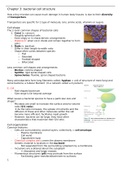Samenvatting
Summary Chapter 3 - Bacterial cell structure. Prescott's Microbiology
- Instelling
- Vrije Universiteit Amsterdam (VU)
Hierbij een samenvatting van chapter 3 bacterial cell structure. De bron is Prescott's Microbiology. Gemaakt naar de leerlijn van Gezondheid & Leven 2023 Microbiologie. 3.1-3.6 en 3.7, 3.8 en 3.10
[Meer zien]





